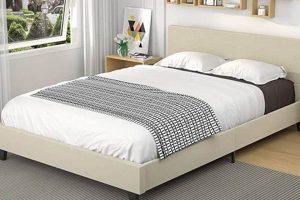The compatibility between bed frames and mattresses of different nominal sizes is a frequent point of confusion. A standard, or Eastern, king-size bed frame is designed to accommodate a mattress measuring approximately 76 inches in width and 80 inches in length. A California king mattress, conversely, measures approximately 72 inches in width and 84 inches in length. As such, a standard king bed frame will not properly fit a California king mattress.
Understanding size discrepancies is crucial for ensuring proper sleep support and preventing mattress damage. A mismatch between the frame and mattress can lead to uneven weight distribution, premature wear, and reduced comfort. Historically, mattress and frame sizes have evolved independently, resulting in variations that require careful consideration during purchase. The small difference in dimensions may seem insignificant, but it can substantially impact the overall quality and longevity of the bedding.
The following sections will detail the potential consequences of using an inappropriately sized frame, explore alternative solutions for accommodating different mattress sizes, and provide guidance on how to accurately measure both frames and mattresses to avoid compatibility issues. Furthermore, this article will highlight readily available bed frame options and explain what considerations to keep in mind when making purchasing decisions.
Compatibility Guidance for Bed Frames and Mattresses
The following provides critical advice for navigating bed frame and mattress compatibility to ensure proper support and avoid potential damage. Due to size differences between types, assessing dimension is necessary.
Tip 1: Verify Mattress Dimensions: Prior to purchasing a bed frame, obtain precise measurements of the mattress. Manufacturer specifications may vary; therefore, direct measurement is essential. For example, a mattress labeled “California King” could deviate slightly from the standard 72-inch by 84-inch measurement.
Tip 2: Understand Frame Specifications: Scrutinize the internal dimensions of the bed frame. A frame described as “King” might not precisely match the standard dimensions. Verify if it’s explicitly designed for standard king or California king mattresses.
Tip 3: Account for Headboard and Footboard: Consider the impact of headboards and footboards on the available space. These components can reduce the effective length of the frame, potentially causing a California king mattress to protrude or fit incorrectly.
Tip 4: Inspect Slat Support: Ensure the bed frame’s slat system is adequately spaced and sturdy enough to support the weight of the mattress. Insufficient support can lead to mattress sagging and premature wear, regardless of size compatibility.
Tip 5: Review Return Policies: Before finalizing a purchase, confirm the retailer’s return policy. This safeguards against incompatibility issues, allowing for exchange or refund if the frame does not properly accommodate the mattress.
Tip 6: Seek Expert Consultation: Consult with a bedding specialist or experienced sales representative for tailored advice. These professionals can offer insights into specific frame and mattress models and provide recommendations based on individual needs and preferences.
Adhering to these guidelines minimizes the risk of incompatibility, ensuring a comfortable and supportive sleep environment. This approach also protects the investment in both the mattress and the bed frame, maximizing their lifespan and performance.
The subsequent section will explore potential modifications and adaptations that can address minor size discrepancies, offering practical solutions for achieving optimal fit and support.
1. Dimension incompatibility
Dimension incompatibility forms the core impediment when considering whether a king bed frame will accommodate a California king mattress. A standard king mattress measures 76 inches wide and 80 inches long, whereas a California king mattress is 72 inches wide and 84 inches long. This disparity indicates that a California king mattress placed on a standard king frame will extend beyond the frame’s length while leaving a gap on either side. This mismatch directly impacts the support provided to the mattress, as the edges lack proper bracing.
The importance of dimension compatibility extends beyond mere aesthetics. Improper support leads to uneven weight distribution, causing premature sagging and wear of the mattress. For instance, the unsupported end of a California king mattress on a standard king frame is susceptible to deformation when weight is applied, thereby shortening its lifespan. Furthermore, the lack of a snug fit can result in instability, leading to uncomfortable sleep and potential injury. Selecting appropriately sized bedding components is thus a practical consideration with long-term implications for both comfort and durability.
In summary, the incompatibility of dimensions between a standard king bed frame and a California king mattress presents a significant challenge. The resulting lack of support compromises the mattress’s structural integrity and reduces its lifespan. Accurately assessing dimensions is crucial when choosing a bed frame to ensure adequate support, comfort, and long-term value. Understanding this ensures bedding investments are maximized and avoid such compatibility issues.
2. Mattress overhang
Mattress overhang is a direct consequence of attempting to use a standard king-size bed frame with a California king mattress. A California king mattress, being longer and narrower than its standard counterpart, will inevitably extend beyond the boundaries of the shorter king frame. This projection occurs primarily at the foot of the bed and, to a lesser extent, along the sides where the California kings narrower width fails to fully meet the frame. The degree of overhang is determined by the precise difference in dimensions between the frame and mattress, but it always results in compromised support.
The significance of mattress overhang extends beyond mere aesthetics. The unsupported portion of the mattress is susceptible to sagging and deformation, particularly when subjected to weight. For instance, frequent sitting or lying near the edge of the overhanging section accelerates wear, reducing the mattress’s overall lifespan and potentially voiding warranties. Furthermore, the overhang creates a tripping hazard and can damage adjacent furniture or walls. The lack of full support also affects sleep quality, as the uneven surface leads to discomfort and inadequate spinal alignment. Real-world examples include individuals experiencing back pain due to the unsupported regions of the mattress collapsing under their weight and users noticing premature sagging along the mattress edges.
In summary, mattress overhang, resulting from attempting to fit a California king mattress on a standard king frame, poses practical and structural challenges. It compromises mattress integrity, reduces sleep comfort, and creates potential safety hazards. Understanding the dimensional incompatibility and the resultant overhang is crucial for making informed purchasing decisions and ensuring proper support for bedding investments. Choosing the correctly sized frame eliminates these issues and maximizes the lifespan and performance of the mattress.
3. Structural support
Structural support constitutes a critical factor when assessing whether a king bed frame is suitable for a California king mattress. Proper structural support ensures the mattress maintains its intended shape, provides consistent comfort, and distributes weight evenly, ultimately impacting the sleeper’s health and the mattress’s longevity. The dimensional differences between king and California king mattresses directly affect the adequacy of this support.
- Weight Distribution
An appropriately sized bed frame provides even weight distribution across the mattress surface. When a California king mattress, which is longer and narrower than a standard king, is placed on a king frame, areas of the mattress lack proper support, leading to concentrated stress points. For example, if a sleeper consistently sits on the unsupported edge, that area can sag prematurely, compromising the mattress’s overall integrity. This uneven weight distribution affects spinal alignment and can lead to discomfort or pain.
- Slat Configuration and Spacing
The slat configuration and spacing of a bed frame are essential for providing consistent support. A frame designed for a king mattress may have slats that are too widely spaced or inadequately positioned to properly support the dimensions of a California king. As an example, wide gaps between the slats can allow portions of the mattress to sink through, resulting in uneven sleeping surfaces. This lack of uniform support can diminish the mattress’s ability to conform to the sleeper’s body, reducing comfort and potentially affecting sleep quality.
- Edge Support
Edge support is crucial for preventing mattress sag and facilitating ease of getting in and out of bed. A standard king bed frame may not provide adequate edge support for a California king mattress, especially along the longer sides where the mattress doesn’t fully reach the frame’s edge. This results in a “roll-off” sensation and accelerates wear along the edges. A practical example involves users experiencing a feeling of instability when sitting on the edge of the bed, coupled with the mattress edges breaking down more rapidly than the central area.
- Center Support Beam
A center support beam, often found in larger bed frames, provides additional reinforcement and prevents sagging in the middle of the mattress. When a California king mattress is used on a standard king frame, the center support may not align correctly with the mattress’s dimensions, leaving areas without adequate reinforcement. For instance, if the center support does not adequately reach the middle of the California king, it might not prevent sagging, especially with two sleepers, leading to discomfort and uneven wear.
These facets highlight the importance of considering structural support when contemplating whether a king bed frame is suitable for a California king mattress. The dimensional discrepancies between the two require careful assessment of weight distribution, slat configuration, edge support, and center support beams. A mismatched frame can lead to discomfort, reduced mattress lifespan, and potential health concerns related to improper spinal alignment. Understanding these implications is essential for making informed decisions about bedding purchases.
4. Aesthetic compromise
Aesthetic compromise arises as a notable consideration when evaluating the compatibility of a king bed frame with a California king mattress. The dimensional differences between these two sizes inevitably lead to visual discrepancies that detract from the overall appearance of the bedding arrangement. The extent of this compromise can vary based on individual preferences, but it consistently presents a deviation from the intended design.
- Visual Proportion
The disparity in proportions between a standard king bed frame and a California king mattress results in an unbalanced visual presentation. The shorter length of the king frame, relative to the California king mattress, causes an overhang that disrupts the clean lines and uniform appearance typically associated with well-matched bedding. This overhang can be particularly noticeable at the foot of the bed, creating a sense of incompleteness or misplacement. For example, decorative elements on the headboard may appear disproportionate to the visible mattress area.
- Gap Formation
Due to the narrower width of a California king mattress compared to a standard king frame, gaps form along the sides of the bed. These gaps create a void between the mattress and the frame, detracting from the seamless and cohesive look of the bed. This can also lead to functional issues as items may fall into these gaps. For instance, pillows and bedding can slip into the crevices, requiring frequent adjustments and diminishing the bed’s aesthetic appeal.
- Headboard Integration
Headboard integration suffers when a California king mattress is placed on a standard king frame. The headboard, designed to align with the dimensions of a king mattress, may appear too wide for the narrower California king. This misalignment disrupts the visual harmony and can make the headboard seem out of place. As an example, the headboard’s decorative elements might extend beyond the mattress’s edges, creating an unbalanced and visually unappealing composition.
- Overall Symmetry
Overall symmetry, a key element in interior design, is compromised when combining mismatched bed frame and mattress sizes. Symmetry provides a sense of order and balance, which is disrupted by the dimensional discrepancies. A California king mattress on a standard king frame loses its symmetrical appearance due to the overhang at the foot and the gaps on the sides, resulting in a visually disjointed arrangement. This lack of symmetry can negatively impact the overall aesthetic of the bedroom.
These considerations regarding aesthetic compromise underscore the importance of selecting appropriately sized bedding components. While functional aspects like support and comfort are paramount, the visual appeal of a bedroom significantly contributes to its overall ambiance. Addressing dimensional discrepancies ensures a harmonious and visually pleasing environment. Failing to match frame and mattress dimensions can result in an uncoordinated and aesthetically unappealing arrangement that detracts from the intended design.
5. Damage potential
The attempt to fit a California king mattress onto a standard king bed frame introduces several damage potentials to both the mattress and the frame. The incompatibility of dimensions creates stress points and uneven support, accelerating wear and potentially compromising the structural integrity of each component. This damage manifests through various mechanisms directly linked to the size mismatch.
One prominent aspect of damage potential involves the mattress itself. The overhang resulting from the California king’s greater length places undue stress on the unsupported edge. This unsupported area is prone to sagging and deformation over time, especially with repeated use or concentrated weight. Edge collapse is a common outcome, diminishing the mattress’s comfort and potentially voiding warranties. Furthermore, the mattress cover can be abraded by friction against the frame’s edges, leading to tears and compromised hygiene. The bed frame is also susceptible to damage. The excessive weight concentrated on certain frame portions can cause warping or bending of slats, side rails, or the central support structure. In extreme cases, the frame may crack or collapse, presenting a safety hazard. For instance, consider a scenario where a bed’s slat system is not sufficiently robust to bear the concentrated weight, leading to slat breakage and consequential mattress damage. Continuous rubbing and friction from the mattress can also mar the finish of the frame, reducing its aesthetic appeal and resale value.
In summary, the ill-advised combination of a California king mattress and a standard king bed frame elevates the risk of damage to both components. The lack of proper support and the resulting stress concentrations lead to premature wear, structural compromise, and potential safety hazards. Recognizing and avoiding this incompatibility is essential for protecting bedding investments and ensuring a safe and comfortable sleep environment.
Frequently Asked Questions
The following addresses common inquiries regarding the interchangeability of standard king bed frames and California king mattresses, providing clarity on potential compatibility issues and offering practical guidance.
Question 1: Will a standard king bed frame properly support a California king mattress?
No, a standard king bed frame will not provide adequate support for a California king mattress. The dimensions differ; a California king mattress is longer and narrower than a standard king, leading to overhang and uneven weight distribution.
Question 2: What are the potential consequences of using a standard king bed frame with a California king mattress?
Consequences include mattress sagging, accelerated wear, compromised comfort, potential frame damage, and an aesthetically unappealing appearance due to the size mismatch.
Question 3: Can modifications be made to a standard king bed frame to accommodate a California king mattress?
Modifications are possible but often require expertise and may compromise the frame’s structural integrity. Extending the frame’s length is a significant undertaking. Consulting a professional is advisable.
Question 4: Is the difference in size between a standard king and a California king mattress significant?
Yes, the dimensional difference is significant. A California king mattress is 4 inches narrower and 4 inches longer than a standard king, resulting in noticeable overhang and inadequate side support when used with a mismatched frame.
Question 5: Should a California king bed frame always be used with a California king mattress?
Yes, for optimal support, comfort, and longevity, a California king mattress should be paired with a California king bed frame. This ensures proper weight distribution and prevents premature wear.
Question 6: What should one consider when selecting a bed frame for a California king mattress?
Consider the frame’s internal dimensions, slat spacing, center support, and overall construction quality. Ensure the frame is specifically designed to accommodate the dimensions and weight of a California king mattress.
In summary, the dimensions of bedding components should align to ensure optimal comfort, support, and longevity. Prioritize a correctly sized frame to avoid potential damage and discomfort.
The subsequent section explores alternative bedding solutions and provides resources for locating appropriately sized frames and mattresses.
Determining Bed Frame and Mattress Compatibility
The preceding analysis clarifies whether a standard king bed frame is suitable for a California king mattress, definitively establishing its inadequacy. Dimensional discrepancies introduce structural vulnerabilities, aesthetic compromises, and potential damage to both the mattress and the frame. Key considerations include weight distribution, slat configuration, edge support, and center beam alignment. Addressing these factors ensures the bedding components perform according to expectation and avoids potential long-term issues.
Prudent decision-making regarding bed frame and mattress selection necessitates careful attention to detail. Purchasing bedding represents a significant investment, and the long-term impact of incorrect choices extends beyond mere inconvenience. Selecting appropriately sized components upholds comfort, promotes sound sleep, and safeguards financial outlay. Therefore, aligning bed frame and mattress dimensions is crucial for maximizing longevity and maintaining the structural integrity of sleep surfaces.




![Best Queen Futon Mattress & Frame [Deals + Guide] Organic & Natural Mattress Buyer’s Guide: Non-Toxic Sleep Solutions Best Queen Futon Mattress & Frame [Deals + Guide] | Organic & Natural Mattress Buyer’s Guide: Non-Toxic Sleep Solutions](https://mattressworldpa.com/wp-content/uploads/2025/07/th-3077-300x200.jpg)

![Best California King Mattress & Frame [Guide] Organic & Natural Mattress Buyer’s Guide: Non-Toxic Sleep Solutions Best California King Mattress & Frame [Guide] | Organic & Natural Mattress Buyer’s Guide: Non-Toxic Sleep Solutions](https://mattressworldpa.com/wp-content/uploads/2025/07/th-3075-300x200.jpg)
![Best Full Size Mattress Metal Frame [Guide & Tips] Organic & Natural Mattress Buyer’s Guide: Non-Toxic Sleep Solutions Best Full Size Mattress Metal Frame [Guide & Tips] | Organic & Natural Mattress Buyer’s Guide: Non-Toxic Sleep Solutions](https://mattressworldpa.com/wp-content/uploads/2025/07/th-3074-300x200.jpg)